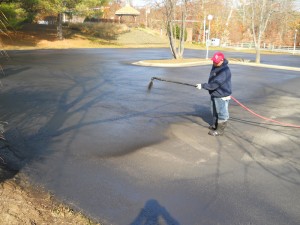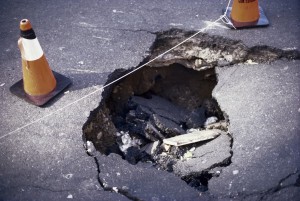Winter has arrived in Maryland, bringing freezing temperatures, blustery winds, and icy precipitation, including sleet and snow. While it can be an exhilarating and invigorating time of year, the cold weather also presents special challenges for people who own businesses. One of those issues that you may not think of right away is damage to parking lots. This can be caused by changes in temperatures such as freezing and thawing. If you notice cracks or potholes in the parking lot of your business, you need to make repairs right away before the problem gets worse.
Blog
Posts Tagged ‘Asphalt Maintenance’
Emergency Cold Tar Patching Through the Winter
Friday, December 22nd, 2017The Environment Effects of Road Salt and Eco-Friendly Alternatives
Friday, December 8th, 2017Road salt is used throughout the country by municipalities and property management companies to keep roadways and parking lots safe. However, road salt is not always the best thing for the asphalt or pavement that it’s being placed on. Beyond how it affects the pavement itself, it’s also important to consider the environmental ramifications of road salt. (more…)
Why Does Asphalt Deteriorate?
Wednesday, November 8th, 2017
While asphalt is one of the most durable materials used in construction, it can also deteriorate over time from errors and improper maintenance.
As one of the most durable materials used in construction, asphalt adds dependability and strength to all paving and building projects. Aside from those factors, the result is also a sleek, professional look that will make people marvel. However, like any other material, over time asphalt will start to show signs of its age and exposure. Even asphalt that is well maintained will begin to deteriorate after some time, depending on its environment and how it’s used. Here are some reasons why asphalt deteriorates. (more…)
How to Deal with Flooding in Parking Lots
Friday, September 8th, 2017
Flooding is a hazard to drivers and is very damaging to the parking lot. Keep reading to see how to stop flooding from occurring.
One of the most important aspects of a parking lot that is often overlooked is its drainage, which can quickly become the main focus with the expected excess of rainfall. Whether the parking lot flooding is natural or man-made, it is a hazard to drivers or pedestrians and is also very damaging to the parking lot. Even though the parking lot might seem like it’s in good condition on the surface, the pooling water will start to eat away the sealcoating and eventually allow water to seep into the pavement and begin to oxidize and deteriorate the pavement. Today we will look at procedures to put in place to deal with unexpected flooding in parking lots. (more…)
What Is Asphalt Seal Coating?
Friday, August 4th, 2017Seal coating is a true barrier between asphalt surfaces and the destructive elements. The term “seal coating” means keeping the redeeming properties of asphalt sealed in to prolong the pavement life and preserve its functional properties. The primary reason to sealcoat an asphalt pavement is to protect the pavement from the deteriorating effects of sun and water. When asphalt pavement is exposed to sun, wind and water, the asphalt hardens, or oxidizes. This causes the pavement to become more brittle. As a result, the pavement will crack because it is unable to bend and flex when exposed to traffic and temperature changes. (more…)
Why Does Asphalt Crack?
Friday, June 9th, 2017
There are many reasons that your asphalt may be cracking — and it’s always best to keep some maintenance tips in mind.
Asphalt is a sticky, black and highly glutinous liquid, or semi-solid form of petroleum. Its primary use is for the construction of driveways and road and occasionally used to seal flat roofs, where it is used as the glue or binder mixed with combined particles to produce asphalt concrete. The most common occurrence of cracked asphalt happens when water seeps into the pavement through open cracks, and potholes occur. When the water freezes, expansion occurs thus widening the crack further. During warm weather, the iced water melts away leaving the cracks with open voids. A pothole emerges when the surrounding walls fall into the void. (more…)
How to Routinely Maintain Your Porous Pavement
Friday, April 7th, 2017
Because porous pavement maintenance requires something a little different than maintenance of regular pavement, we’re going to go over the general checklist for maintaining your porous pavement.
Porous pavement is a very special kind of pavement that drains water into the ground below it very strategically. This system is delicate, and needs to be supported in every way possible. Most support must come from the owner of the pavement, in order to make sure everything is working as it should. Because porous pavement maintenance requires something a little different than maintenance of regular pavement, we’re going to go over the general checklist for maintaining your porous pavement. Read on for more information.
3 Common Questions Surrounding Seal Coating
Thursday, February 16th, 2017
Seal coating is when a professional applies a coal tar emulsion mix over the top of asphalt pavement to protect it and keep it looking new.
Most pavement and driveway owners know that they should get their driveway seal coated, but they aren’t sure exactly what it is or why it should be done. We’ll give you the answer to that first question as a bonus! Seal coating is when a professional applies a coal tar emulsion mix over the top of asphalt pavement to protect it and keep it looking new. Think of seal coating like putting sunscreen on before heading out for a day at the beach.
Why You Should Be Filling Cracks in Your Pavement
Friday, November 11th, 2016
Cracks aren’t something you can just put behind you; cracks in pavement are actually one of the biggest causes of further destruction.
Cracks happen in all kinds of pavements eventually. No matter how well the pavement is installed, wear and tear is inevitable. But cracks aren’t something you can just put behind you; cracks in pavement are actually one of the biggest causes of further destruction. Filling cracks as soon as you see them is vital. Your pavement needs to be maintained properly, and filling cracks is an important step. Don’t believe us? Here are some reasons why you should be filling the cracks in your pavement.
How to Prevent Weed Growth Between Pavement Cracks
Friday, October 7th, 2016
Are you tired of constantly buying chemicals in order to rid your pavement of weeds? It can be a chore to remove them by hand, and power washing can sometimes damage pavement.
Are you tired of constantly buying chemicals in order to rid your pavement of weeds? It can be a chore to remove them by hand, and power washing can sometimes damage pavement. Weeds can crack pavement and damage it, as well as causing other issues like tripping hazards. It’s also pretty ugly once the weeds grow in too much, and then you’ve got a huge problem on your hands. So, how can you prevent the growth before it starts? Read on to find out!




















